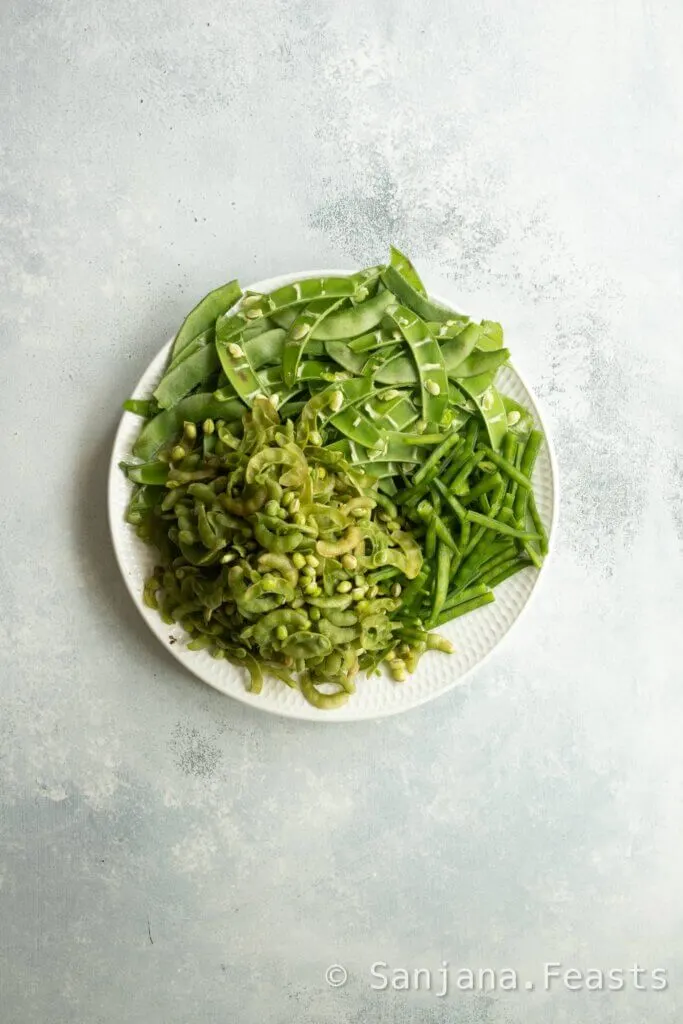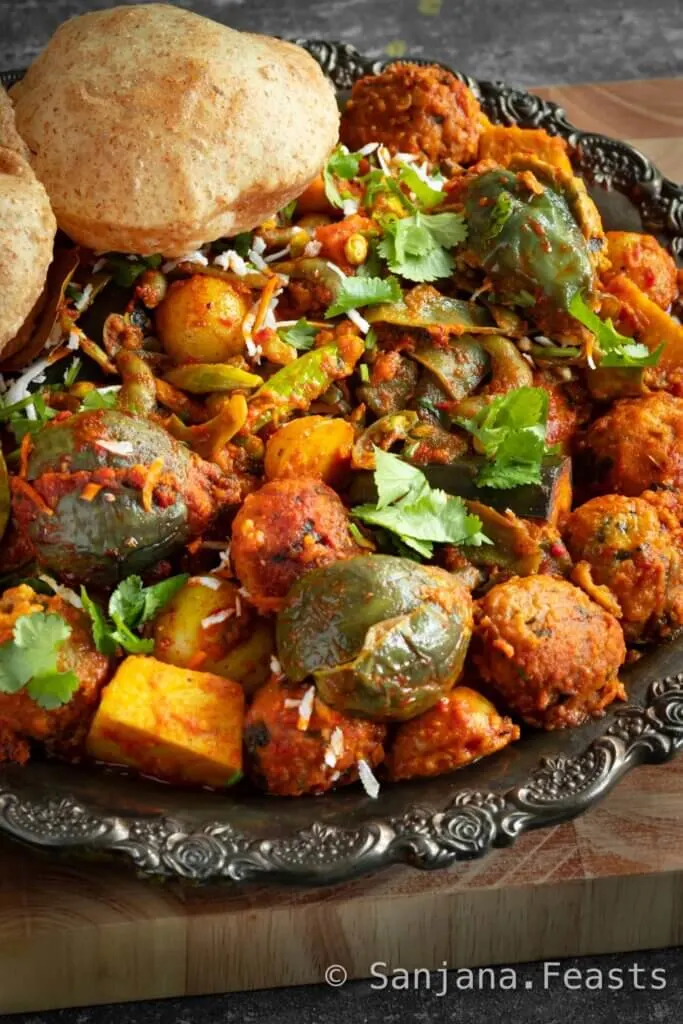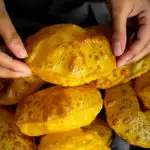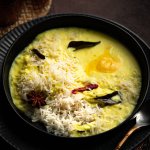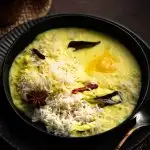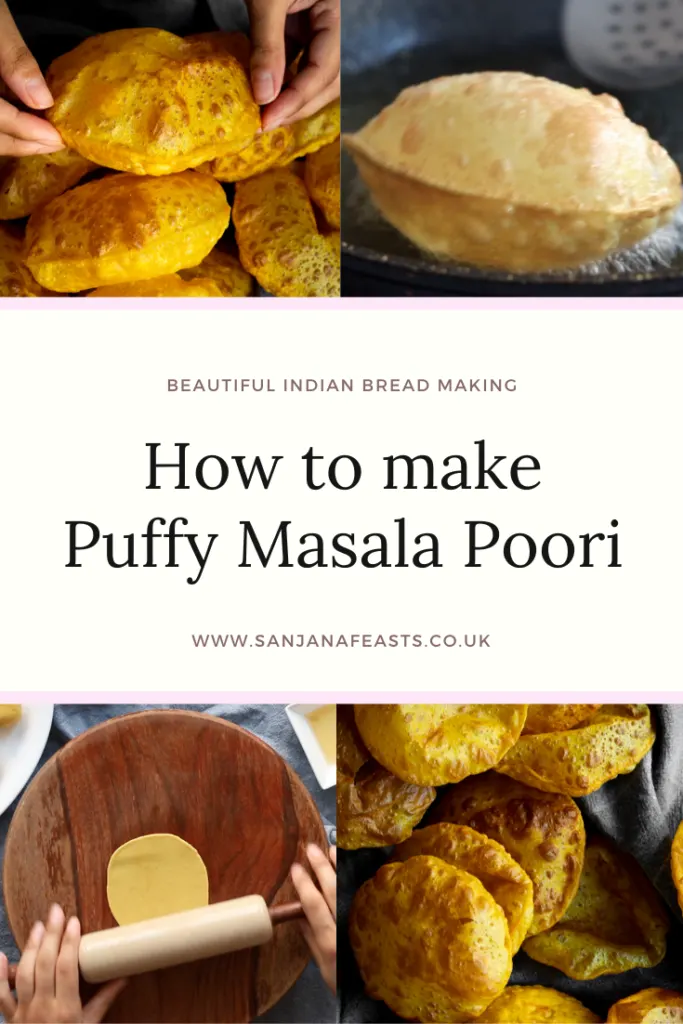You might be happy to hear that for ease and convenience, we’ll prepare this recipe for Kathiyawadi Undhiyu in a more modern kitchen-friendly manner – all without compromising on the classic flavours! It’s usually a one-pot meal but I do things a little differently in order to make sure everything cooks up evenly. This is a foolproof method for making Undhiyu. Don’t be put off by the long list of ingredients. The steps for preparing this dish are actually very straightforward and takes more time than skill. Follow my simple Undhiyu recipe video and you’ll have the most perfect Kathiyawadi version, every time. This recipe for Perfect Kathiyawadi Undhiyu is:
VeganTraditional Gujarati styleEasy to followDelicious with Poori, Shrikhand and Daal-Bhaat, Gujarati wedding style
If you ever want to express your love to a Gujarati, take the time and effort to make Undhiyu – it takes time, patience and effort. Undhiyu is a dish that brings people together; whether it’s the act of cooking it in the kitchen (all hands on deck), or gathering round the table to feast.
What are the main ingredients in Undhiyu?
Vegetables for Undhiyu
Baby aubergines Choose small, firm aubergines. These are best for stuffing. To prepare aubergines for undhiyu, slit the aubergine into quarters from the bottom, slicing to the tip but not all the way through. Green bananas (matoke) These are not the same as regular eating bananas or plantains. Check out a fruit and veg market and find the small green matoke popular in Indian and African cooking. Indeed, their texture is much more starchy and not sweet at all. They should be very firm, green and not yellow in the slightest. To prepare matoke for undhiyu, slice off the tip, cut in half or thirds and slit in half lengthways, but not all the way through. Baby potatoes Choose small, waxy potatoes. Scrub them clean and slit them in half lengthways, but not all the way through. They will cook quickly and above all, this will allow for stuffing. Elephant foot yam (suran) There’s no need to buy a whole suran for this recipe. Since they are quite large, you can buy halves and quarters in the market. To prepare suran for undhiyu, peel the outer brown skin with a vegetable peeler and cut into rough chunks, about 2cm x 2cm. Sweet potato (white or purple fleshed) Orange-fleshed sweet potatoes can be quite watery and turn soft upon cooking. This means they will squash easily so white or purple flesh sweet potatoes work best for undhiyu. You can buy these in fruit and vegetable markets. To prepare sweet potatoes for undhiyu, peel the outer skin with a vegetable peeler and cut into rough chunks, about 2cm x 2cm. Tindora (ivy gourd) This member of the gourd family is usually no larger than the average pinky finger. It’s most popular in southern Indian states but is a common vegetable across Indian cookery. The skin of tindora is thin and the flavour very subtle. Inside, you’ll find lots of small seeds although far less moisture than most gourds. This means that once you cook the tindora, they retain their crunch. To prepare tindora for undhiyu, top and tail the gourds and finally, slice into quarters lengthways. Valor (hyacinth beans) These large, flat beans look similar to broad beans. Both the pods and beans inside are edible. To prepare valor for undhiyu, first snap off the top, leaving the string side attached. Gently pull down to string the pods and pop open to remove the beans (lilva). Watch my video for a step-by-step visual of how to do this. Surti Papdi (whole) Small beans in pods, similar to valor. Both the pods and beans inside are edible. Buy both in your local fruit and veg market. To prepare Surti papdi for undhiyu, wash the beans well in plenty of water. To prepare Surti papdi for undhiyu, first snap off the top, but the string side attached. Gently pull down to string the pods and pop open to remove the beans (lilva). Watch my video for a step-by-step visual of how to do this. You can also buy these frozen to save time. Guvar (cluster beans) Cluster beans. These long, flat beans are also called “guar”, “gavar” and “gawar” depending on regional Indian language and dialect. To prepare guvar for undhiyu, wash them well, top and tail them and then cut in half.
Stuffing for the vegetables
Peanuts Grind the peanuts coarsely so they are of uniform size. I use raw, red skin peanuts. I took the skins off but feel free to keep them on if you prefer. Spices A combination of different spices, herbs and tomatoes also go into this flavoursome stuffing. These include chilli, garlic, ginger and coriander. Pour hot oil over the top of the mixture to temper everything and create a paste.
Methi muthiya (dumplings) for Perfect Kathiyawadi Undhiyu
What is undhiyu without muthiya? It’s the most sought-after part of the undhiyu, in my experience! Having been to dozens of Gujarati weddings, I always make sure I ask for extra methi muthiya at lunchtime. They soak up all the flavours of the gravy and provide deliciously-intense flavours and textures. I choose to deep fry them because this is the most traditional method. You can, however, try air frying or baking them may lose their shape ever so slightly, however. Here’s what goes into Methi muthiya for Undhiyu… Wholewheat flour Chapati atta or wholewheat flour makes up the base of the dumpling because it provides structure and binding. You can use plain flour but the muthiya will be much harder in texture due to the higher proportion of gluten in plain (all-purpose) flour. Gram flour (besan) Firstly, this is essential for an iconic, nutty flavour. Secondly, the gram flour prevents the muthiya from soaking in too much oil when deep frying. Methi (fenugreek leaves) Like undhiyu isn’t undhiyu without muthiya, muthiya aren’t muthiya without methi! You can use either fresh methi or dried (kasoori) methi for the methi muthiya, although the former is better. Note that if you’re using dried methi, you’ll just need a few teaspoons of it. It’s potent stuff! Spices As ever, chilli powder, garlic, ginger and salt are essential additions to methi muthiya. After that, I add a small amount of oil and bicarbonate of soda (baking soda) for tenderness and lightness. Why? Because there’s nothing worse than hard methi muthiya in Gujarati undhiyu!
Undhiyu gravy
Tomatoes A core ingredient in Kathiyawadi undhiyu. It’s important to note that tomatoes are not added to every style of undhiyu. See below for more information on different styles of this vegetarian curry. Many types of undhiyu are tomato-less, but in Kathiyawadi undhiyu, it’s imperative for tanginess and colour. I use fresh tomatoes and blitz them in a blender, however you can also choose to use tomato passata (sieved tomatoes) from a carton or jar (although, not pizza sauce!). Spices An inital tempering of mustard seeds, cumin seeds, sesame seeds and ajwain provide a building block of flavour for this rich, tomatoey gravy. It’s the way many Gujarati curries begin and this rule applies for undhiyu too. Leftover stuffing masala After we stuff our vegetables, any additional stuffing masala is also added to the gravy. It’s packed full of flavour! Crushed muthiya Top tip! For amazing flavour and texture, add a couple of crushed methi muthiya to the gravy. As it cooks, the gravy will thicken (due to the flours in the muthiya) and the wonderful aroma of methi will permeate throughout the entire dish. Ultimately, this step really brings the undhiyu together.
The tadka (tempering)
Oil Try not to skimp on the oil in this recipe. It’s there for a reason and will create the most wonderful undhiyu experience. This is a dish for sharing, enjoying and making memories over so try to do it the real deal way if you really want to enjoy it. Spices A few whole spices like bay leaves and some ground ones too will add the finishing touches to the undhiyu. Finally, add a sprinkle of fresh coconut and coriander leaves on top to complete the dish.
How to serve Gujarati Undhiyu | What goes with Undhiyu
Pile the steaming hot Undhiyu onto a platter or into a large so you can separate some of the vegetables and muthiya out. Serve Undhiyu with poori (a puffed, fried bread), Shrikhand (sweet hung yoghurt with cardamom and saffron), Gujarati Daal, Rice and your favourite pickles and salad.
Types of Undhiyu
Surti Undhiyu
Probably the most famous of all varieties of Undhiyu is Surti Undhiyu. It’s green in colour, typically tomato-less and packed with the fragrance of coriander and coconut.
Jain Undhiyu
The version of Undhiyu enjoyed by those who practice Jainism is free from roots, onions and garlic. Of course, if you want to adapt this recipe, feel free to skip these ingredients and add more chilli, ginger and plenty of asafoetida.
Kathiyawadi Undhiyu
We’re making a great version of it here! Tomatoey, rich and a true celebration of seasonal vegetables. It’s tangy, spicy and sweet. Indeed, these are iconic Gujarati flavours that remind me of wedding feasts.
Wedding Undhiyu
As above! Most Gujarati wedding Undhiyu will be a tomatoey variety, however it is likely free from onions and garlic (like the Jain version) due to many people having dietary restrictions or following a Sattvic diet.
Healthy Undhiyu
It’s possible to make Undhiyu without too much oil, deep frying, salt and sugar. For example, you may choose to bake or air fry the methi muthiya and steam all of the vegetables. This is ultimately a personal choice and the finished Undhiyu will still taste great. Feel free to swap sugar for jaggery and reduce the amount of salt as per your taste, too.
Perfect Kathiyawadi Undhiyu Recipe | How to make Gujarati Undhiyu
Pin this recipe for later! Perfect Kathiyawadi Undhiyu
If you like this Perfect Kathiyawadi Undhiyu, you’ll love my recipe for Masala Poori
Love Sanjana Make the Muthiya in advance and freeze to save time. Add them to the undhiyu straight from frozen. To reheat, place the leftover undhiyu in a microwave-safe bowl, cover and microwave on high power until piping hot. Serving suggestionServe Undhiyu with poori (a puffed, fried bread), Shrikhand (sweet hung yoghurt with cardamom and saffron), Gujarati Daal, Rice and your favourite pickles and salad. Share this recipe









